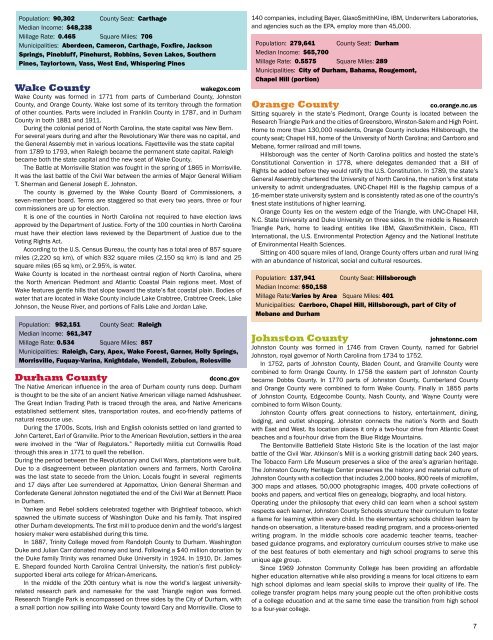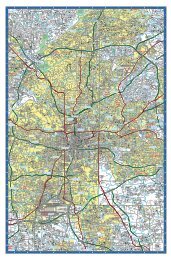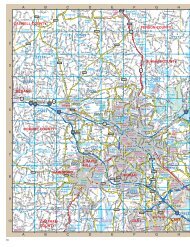Create successful ePaper yourself
Turn your PDF publications into a flip-book with our unique Google optimized e-Paper software.
Population: 90,302 County Seat: Carthage<br />
Median Income: $48,238<br />
Millage Rate: 0.465 Square Miles: 706<br />
Municipalities: Aberdeen, Cameron, Carthage, Foxfire, Jackson<br />
Springs, Pinebluff, Pinehurst, Robbins, Seven Lakes, Southern<br />
Pines, Taylortown, Vass, West End, Whispering Pines<br />
Wake County<br />
wakegov.com<br />
Wake County was formed in 1771 from parts of Cumberland County, Johnston<br />
County, and Orange County. Wake lost some of its territory through the formation<br />
of other counties. Parts were included in Franklin County in 1787, and in Durham<br />
County in both 1881 and 1911.<br />
During the colonial period of North Carolina, the state capital was New Bern.<br />
For several years during and after the Revolutionary War there was no capital, and<br />
the General Assembly met in various locations. Fayetteville was the state capital<br />
from 1789 to 1793, when Raleigh became the permanent state capital. Raleigh<br />
became both the state capital and the new seat of Wake County.<br />
The Battle at Morrisville Station was fought in the spring of 1865 in Morrisville.<br />
It was the last battle of the Civil War between the armies of Major General William<br />
T. Sherman and General Joseph E. Johnston.<br />
The county is governed by the Wake County Board of Commissioners, a<br />
seven-member board. Terms are staggered so that every two years, three or four<br />
commissioners are up for election.<br />
It is one of the counties in North Carolina not required to have election laws<br />
approved by the Department of Justice. Forty of the 100 counties in North Carolina<br />
must have their election laws reviewed by the Department of Justice due to the<br />
Voting Rights Act.<br />
According to the U.S. Census Bureau, the county has a total area of 857 square<br />
miles (2,220 sq km), of which 832 square miles (2,150 sq km) is land and 25<br />
square miles (65 sq km), or 2.95%, is water.<br />
Wake County is located in the northeast central region of North Carolina, where<br />
the North American Piedmont and Atlantic Coastal Plain regions meet. Most of<br />
Wake features gentle hills that slope toward the state’s flat coastal plain. Bodies of<br />
water that are located in Wake County include Lake Crabtree, Crabtree Creek, Lake<br />
Johnson, the Neuse River, and portions of Falls Lake and Jordan Lake.<br />
Population: 952,151 County Seat: Raleigh<br />
Median Income: $61,347<br />
Millage Rate: 0.534 Square Miles: 857<br />
Municipalities: Raleigh, Cary, Apex, Wake Forest, Garner, Holly Springs,<br />
Morrisville, Fuquay-Varina, Knightdale, Wendell, Zebulon, Rolesville<br />
Durham County<br />
dconc.gov<br />
The Native American influence in the area of Durham county runs deep. Durham<br />
is thought to be the site of an ancient Native American village named Adshusheer.<br />
The Great Indian Trading Path is traced through the area, and Native Americans<br />
established settlement sites, transportation routes, and eco-friendly patterns of<br />
natural resource use.<br />
During the 1700s, Scots, Irish and English colonists settled on land granted to<br />
John Carteret, Earl of Granville. Prior to the American Revolution, settlers in the area<br />
were involved in the “War of Regulators.” Reportedly militia cut Cornwallis Road<br />
through this area in 1771 to quell the rebellion.<br />
During the period between the Revolutionary and Civil Wars, plantations were built.<br />
Due to a disagreement between plantation owners and farmers, North Carolina<br />
was the last state to secede from the Union. Locals fought in several regiments<br />
and 17 days after Lee surrendered at Appomattox, Union General Sherman and<br />
Confederate General Johnston negotiated the end of the Civil War at Bennett Place<br />
in Durham.<br />
Yankee and Rebel soldiers celebrated together with Brightleaf tobacco, which<br />
spawned the ultimate success of Washington Duke and his family. That inspired<br />
other Durham developments. The first mill to produce denim and the world’s largest<br />
hosiery maker were established during this time.<br />
In 1887, Trinity College moved from Randolph County to Durham. Washington<br />
Duke and Julian Carr donated money and land. Following a $40 million donation by<br />
the Duke family Trinity was renamed Duke University in 1924. In 1910, Dr. James<br />
E. Shepard founded North Carolina Central University, the nation’s first publiclysupported<br />
liberal arts college for African-Americans.<br />
In the middle of the 20th century what is now the world’s largest universityrelated<br />
research park and namesake for the vast <strong>Triangle</strong> region was formed.<br />
Research <strong>Triangle</strong> Park is encompassed on three sides by the City of Durham, with<br />
a small portion now spilling into Wake County toward Cary and Morrisville. Close to<br />
140 companies, including Bayer, GlaxoSmithKline, IBM, Underwriters Laboratories,<br />
and agencies such as the EPA, employ more than 45,000.<br />
Population: 279,641 County Seat: Durham<br />
Median Income: $65,700<br />
Millage Rate: 0.5575 Square Miles: 289<br />
Municipalities: City of Durham, Bahama, Rougemont,<br />
Chapel Hill (portion)<br />
Orange County<br />
co.orange.nc.us<br />
Sitting squarely in the state’s Piedmont, Orange County is located between the<br />
Research <strong>Triangle</strong> Park and the cities of Greensboro, Winston-Salem and High Point.<br />
Home to more than 130,000 residents, Orange County includes Hillsborough, the<br />
county seat; Chapel Hill, home of the University of North Carolina; and Carrboro and<br />
Mebane, former railroad and mill towns.<br />
Hillsborough was the center of North Carolina politics and hosted the state’s<br />
Constitutional Convention in 1778, where delegates demanded that a Bill of<br />
Rights be added before they would ratify the U.S. Constitution. In 1789, the state’s<br />
General Assembly chartered the University of North Carolina, the nation’s first state<br />
university to admit undergraduates. UNC-Chapel Hill is the flagship campus of a<br />
16-member state university system and is consistently rated as one of the country’s<br />
finest state institutions of higher learning.<br />
Orange County lies on the western edge of the <strong>Triangle</strong>, with UNC-Chapel Hill,<br />
N.C. State University and Duke University on three sides. In the middle is Research<br />
<strong>Triangle</strong> Park, home to leading entities like IBM, GlaxoSmithKlein, Cisco, RTI<br />
International, the U.S. Environmental Protection Agency and the National Institute<br />
of Environmental Health Sciences.<br />
Sitting on 400 square miles of land, Orange County offers urban and rural living<br />
with an abundance of historical, social and cultural resources.<br />
Population: 137,941 County Seat: Hillsborough<br />
Median Income: $50,158<br />
Millage Rate:Varies by Area Square Miles: 401<br />
Municipalities: Carrboro, Chapel Hill, Hillsborough, part of City of<br />
Mebane and Durham<br />
Johnston County<br />
johnstonnc.com<br />
Johnston County was formed in 1746 from Craven County, named for Gabriel<br />
Johnston, royal governor of North Carolina from 1734 to 1752.<br />
In 1752, parts of Johnston County, Bladen Count, and Granville County were<br />
combined to form Orange County. In 1758 the eastern part of Johnston County<br />
became Dobbs County. In 1770 parts of Johnston County, Cumberland County<br />
and Orange County were combined to form Wake County. Finally in 1855 parts<br />
of Johnston County, Edgecombe County, Nash County, and Wayne County were<br />
combined to form Wilson County.<br />
Johnston County offers great connections to history, entertainment, dining,<br />
lodging, and outlet shopping. Johnston connects the nation’s North and South<br />
with East and West. Its location places it only a two-hour drive from Atlantic Coast<br />
beaches and a four-hour drive from the Blue Ridge Mountains.<br />
The Bentonville Battlefield State Historic Site is the location of the last major<br />
battle of the Civil War. Atkinson’s Mill is a working gristmill dating back 240 years.<br />
The Tobacco Farm Life Museum preserves a slice of the area’s agrarian heritage.<br />
The Johnston County Heritage Center preserves the history and material culture of<br />
Johnston County with a collection that includes 2,000 books, 800 reels of microfilm,<br />
300 maps and atlases, 50,000 photographic images, 400 private collections of<br />
books and papers, and vertical files on genealogy, biography, and local history.<br />
Operating under the philosophy that every child can learn when a school system<br />
respects each learner, Johnston County Schools structure their curriculum to foster<br />
a flame for learning within every child. In the elementary schools children learn by<br />
hands-on observation, a literature-based reading program, and a process-oriented<br />
writing program. In the middle schools core academic teacher teams, teacherbased<br />
guidance programs, and exploratory curriculum courses strive to make use<br />
of the best features of both elementary and high school programs to serve this<br />
unique age group.<br />
Since 1969 Johnston Community College has been providing an affordable<br />
higher education alternative while also providing a means for local citizens to earn<br />
high school diplomas and learn special skills to improve their quality of life. The<br />
college transfer program helps many young people cut the often prohibitive costs<br />
of a college education and at the same time ease the transition from high school<br />
to a four-year college.<br />
7















![[DC-2017] NorthFulton CommunityProfiles-020317](https://img.yumpu.com/56831475/1/190x247/dc-2017-northfulton-communityprofiles-020317.jpg?quality=85)

